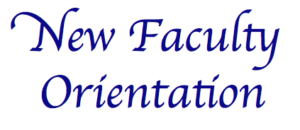By Lauren Scharff, Ph.D., U. S. Air Force Academy *
When and how might faculty become aware of metacognition in general, how student metacognition might enhance student learning, and how personal metacognition might enhance their own teaching? Ideally, faculty learned about metacognition as students and thereafter consciously engaged in metacognitive practices as learners and developing professionals. Based on conversations with many faculty members, however, this is not the case. It certainly wasn’t the case for me. I don’t remember even hearing the term metacognition until after many years of working as a professor. Even now most new faculty seem to only have a vague familiarity with the term “metacognition” itself, and few claim to have spent much time considering how reflection and self-regulation, key components of metacognition, should be part of their own practice or part of the skill set they plan to help develop in their students.
While this reality is not ideal (at least for those of us true believers in the power of metacognition), realization of this lack of understanding about metacognition provides opportunities for faculty development. And why not start right at the beginning when faculty attend new faculty orientation?
At my institution this summer, we did just that. Our Director of Faculty Development, Dr. Marc Napolitano, worked the topic into his morning session on student learning. We designed a follow-on, small-group discussion session that encouraged faculty to actively engage in reading, personal application, and discussion of metacognition.
The reading we chose was one of my favorite metacognition articles, Promoting Student Metacognition, by Dr. Kimberly Tanner (2012). The session was only 40 minutes, so we only had them read a few pages of the article for the exercise, including her Table 1, which provides a series of questions students can ask themselves when planning, monitoring, evaluating their learning for a class session, while completing homework, while preparing for an exam. We had the new faculty jot down some reflections based on their responses to several guided prompts. Then we had time for discussion. I facilitated one of the small groups and was thus able to first-hand hear some of their responses.
Example questions:
- What type of student were you as an undergraduate? Did you ever change your approach to learning as you went through school?
- You obviously achieved success as an undergraduate, but do you think that you could have been more successful if you had better understood the science of learning and had teachers incorporate it into their courses?
- If you had to share a definition of metacognition [from the reading] with students – and explain to them why it is an essential practice in learning – which definition would you use and how would you frame it with students?
- If you wished to incorporate metacognition into your class, what approach(es) currently seems most practical for you? Why?
- Which 3-4 of the questions in Table 1 seem like they would most helpful to use in your class? Why do these questions stand out, and how might they shape your class?
The discussion following the reading and reflection time was very rich. Only one member of my group of eight reported a good prior understanding of metacognition and how it could be incorporated into course design (she had just finished a PhD in physics education). Two others reported having vague prior familiarity with the term. However, after participating in these two faculty development sessions, all of them agreed that learning about the science of learning would have been valuable as a student regardless of level (K-12 through graduate school).
The faculty in my group represent a wide variety of disciplines, so the ways of incorporating metacognition and the questions from the table in the reading that most appealed to them varied. However, that is one of the wonderful things about designing courses or teaching practices to support student metacognition – there are many ways to do so. Thus, it’s not a problem to fit them to your way of teaching and your desired course outcomes.
We also spent a little time discussing metacognitive instruction: being aware of their choices as instructors and their students’ engagement and success, and using that awareness to guide their subsequent choices as instructors to support their students’ learning. They quickly understood the parallels with student metacognitive learning (students being aware of their choices and whether or not those choices are leading to success, and using that awareness to guide subsequent choices related to their learning). Our small groups will continue to meet throughout the coming year as a continuation of our new faculty development process. I look forward to continuing our conversations and further supporting them in becoming metacognitive instructors and promoting their students’ development as metacognitive learners.
————
Tanner, K. (2012). Promoting student metacognition. CBE—Life Sciences Education; Vol. 11, 113–120
* Disclaimer: The views expressed in this document are those of the author and do not reflect the official policy or position of the U. S. Air Force, Department of Defense, or the U. S. Govt.

